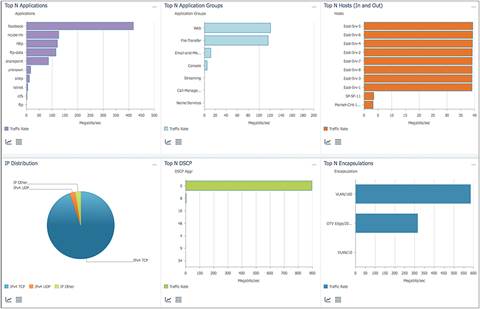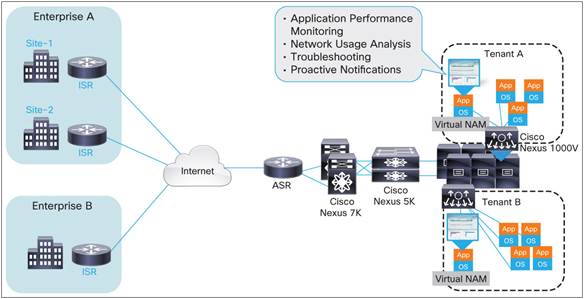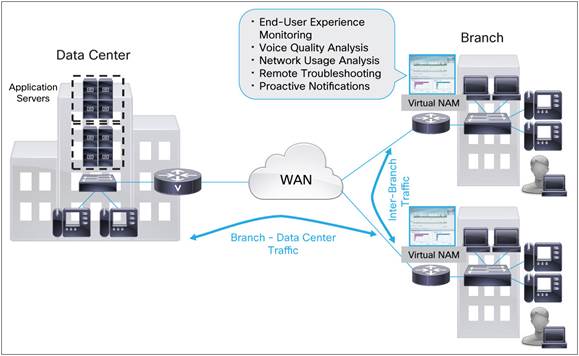Cisco Prime Virtual Network Analysis Module Data Sheet
Available Languages
Virtualization and cloud create exciting business transformation opportunities, innovative service delivery models, and improved economics. At the same time, they introduce a new dimension of service delivery challenges that demand real-time application and network visibility to boost operational agility.
Product Overview
Cisco Prime™ Virtual Network Analysis Module (vNAM) delivers operational agility by permitting deployment almost anywhere in the network to improve service levels. You can deploy the vNAM in the cloud to monitor hosted workloads, at remote sites to characterize the end-user experience, or almost anywhere in the network to eliminate blind spots. It combines deep application awareness, insightful performance analytics, and comprehensive network visibility to empower network administrators to efficiently and effectively manage their networks.

Cisco Prime vNAM’s versatility allows you to:
● Gain Layer 4-Layer 7 visibility using Cisco® Network-Based Application Recognition 2 (NBAR2) natively to easily identify business-critical applications
● Understand traffic behavior within overlay technologies such as VXLAN, LISP, and OTV
● Analyze network usage by application, host or Virtual Machine (VM), and conversation to identify bottlenecks that may affect performance and availability
● Troubleshoot performance problems by combining detailed traffic flow and packet analysis consistently across physical and virtual environments
● Validate infrastructure updates such as WAN optimization, Cisco TrustSec®, and Quality-of-Service (QoS) policy changes
● Take advantage of an integrated web-based interface to manage a site remotely, eliminating the need to backhaul the data to a centralized location and saving WAN bandwidth
Cisco Prime vNAM comes with a remotely accessible web-based management and reporting console (Figure 1), which runs the Cisco Prime Network Analysis Module Software. The software includes prepackaged dashboards that provide an immediate view of network performance and workflows that help accelerate operational decisions.
Extending Cisco Application Visibility and Control to the Data Center
With Cisco Prime vNAM 6.2, the vNAM just got richer. Cisco Prime vNAM 6.2 builds on the features and improvements in 6.1. Specifically, 6.2 terminates Encapsulated Remote Switched Port Analyzer (ERSPAN), extends video traffic monitoring capabilities, and implements a smart licensing scheme. Terminating the high-speed ERSPAN at the vNAM, rather than at the switch, enables the vNAM to access the Type III ERSPAN header. The benefits are that the vNAM can be an IP endpoint as well as a SPAN destination, and can perform centralized packet-level monitoring and troubleshooting. With the new video monitoring capabilities, the vNAM can now monitor live video sessions and provide video quality and analytics, similar to voice/Real-Time Protocol (RTP) calls. Smart licensing allows the user to dynamically choose performance levels (150 Mbps or 1 Gbps). However, the traditional licensing scheme is also available, in case smart licensing is unavailable or not suitable in a specific deployment. All these features are in addition to Cisco NBAR2, implemented in Cisco Prime vNAM 6.1. NBAR2 is a Cisco technology included in Cisco Application Visibility and Control (AVC) solutions that performs Deep Packet Inspection (DPI) to automatically recognize and classify applications to Layer 7. With it, the vNAM can provide visibility into the performance of your business-critical applications, no matter where they are hosted or how they are distributed. It can tell you whether transaction times are fast or slow. It can give you information on who’s accessing the apps, which ones, how much, and when. And with these insights, it can help you prioritize those that the business depends on and throttle those that are less relevant. It enables more efficient and more economical operations. And all of it is now included natively in Cisco Prime vNAM.
Cisco Prime vNAM Features and Benefits
The Cisco Prime vNAM offers an extensive set of features (Table 1), all in one value-based solution.
Table 1. Cisco Prime vNAM Features and Benefits
Examples of Deployment Scenarios
Monitor Workloads in the Multitenant Cloud
Deployed in a tenant network container (Figure 2), Cisco Prime vNAM analyzes the TCP-based interactions for the hosted workload to assess performance. It provides metrics such as transaction time, server response time, application delay, and more. Setting performance thresholds helps to proactively detect application response time issues, minimizing the risk of violating service-level objectives. Cisco Prime vNAM also provides insight into network usage by applications, top talkers, and conversations to help optimize use of the cloud infrastructure, including overlay technologies such as VXLAN and LISP.

Simplify Remote-Site Manageability
When deployed at a remote site, Cisco Prime vNAM can help network administrators characterize the end-user experience (Figure 3), profile application traffic, and troubleshoot performance problems to permit cost-effective services delivery across Cisco Enterprise Networks. An integrated web-based interface allows administrators to access vNAM remotely at any time and from anywhere to gather network and application performance insights, eliminating the need to send the data to a centralized location for analysis. The vNAM can monitor all traffic entering and leaving the remote site, identify the applications consuming the most bandwidth, proactively alert you to degradation in application performance, assess whether control and optimization techniques are effectively implemented, and help you contextually troubleshoot performance problems.

Licensing
Cisco offers two vNAM licenses, NAM-VX10 and NAM-VX20 (Table 2). They are distinguished by their traffic monitoring throughput. Both vNAMs support the same feature set.
Licensing for the vNAMs takes advantage of standard Cisco Software Licensing, for which additional information is available at https://www.cisco.com/go/clm. The Cisco Prime vNAM includes a 60-day evaluation license*. The software can be downloaded from the Cisco Promotional Software Store.
Table 2. Cisco Prime vNAM License Information
| vNAM License Part Number | Description | Supported Virtual Environment | Traffic Monitoring Performance |
| R-NAM-VX10-6.2-K9= | Cisco Prime Virtual NAM (NAM-VX10) Software Version 6.2 | Red Hat Enterprise Linux KVM 0.12 or later, | Up to 150 Mbps |
| R-NAM-VX20-6.2-K9= | Cisco Prime Virtual NAM (NAM-VX20) Software Version 6.2 | Red Hat Enterprise Linux KVM 0.12 or later, | Up to 1 Gbps |
Product Specifications
Table 3 provides the specifications for the Cisco Prime vNAM.
Table 3. Product Specifications
| Feature | |
| System requirements (both vNAM licenses) | Cisco Prime vNAM can be deployed on any x86 platform. The system requirements include: ● Two 64-bit CPUs ● Two virtual Ethernet ports ● Network Interface Card (NIC) driver type: VMXNET3 (for ESXi) and virtio (for KVM) ● 4 GB RAM ● 100 GB disk space |
| The Cisco Prime vNAMS are standards compliant. They support the following major MIB groups: ● Remote Monitoring (RMON; RFC 2819): Alarm and Event groups only ● RMON2 (RFC 2021): trapDestTable only ● Cisco Discovery Protocol ● EntityMIB (RFC 2737) | |
| The Cisco Prime vNAM supports two protocol classification modes, DPI (NBAR2) and Classic. A list of the NBAR2 protocols supported in NAM 6.2 can be found at: NBAR2 Protocol Packs for NAM can be found, when available, on the Cisco Prime NAM Software support site at: https://www.cisco.com/c/en/us/support/cloud-systems-management/prime-network-analysis-module-software/tsd-products-support-general-information.html. The DPI mode is the default mode. Cisco Prime vNAM in Classic mode identifies hundreds of unique protocols (Layers 2 through 4) and automatically detects unknown protocols. It also supports URL-based application definition. Supported protocols include, but are not limited to: ● TCP and User Datagram Protocol (UDP) over IP, including IPv6 ● HTTP and HTTPS ● Voice over IP (VoIP) including Skinny Client Control Protocol (SCCP), Real-Time Protocol/Real-Time Control Protocol (RTP/RTCP), Media Gateway Control Protocol (MGCP), and Session Initiation Protocol (SIP) ● SIGTRAN protocols ● Mobile IP protocols, including General Packet Radio Service (GPRS) Tunneling Protocol (GTP) ● SAN protocols ● Database protocols ● Peer-to-peer protocols ● Switch and router protocols ● Cisco proprietary protocols ● Unknown protocols by TCP/UDP ports and Remote Procedure Call (RPC) program numbers | |
| Custom applications | Cisco Prime vNAM supports custom applications. These applications can be defined on the basis of port, port range, server IP address, server IP address range, or HTTP URL. |
Warranty Information
Find warranty information on Cisco.com at the Product Warranties page.
Ordering Information
Cisco Prime vNAM can be purchased through regular Cisco sales and distribution channels worldwide. The order can be placed using the Cisco Ordering Homepage. The software can be downloaded from the Cisco Promotional Software Store. Table 2 provides ordering information for Cisco Prime vNAM licenses.
Cisco Services
Application Support
Network-centered software applications are the core of your most critical business operations, helping to enable continuous communication and collaboration with colleagues, customers, and business partners. Cisco and our authorized partners offer software application support services that can help customers maximize the availability, security, and performance of important business applications. Adding application support to traditional service offerings such as Cisco SMARTnet™ creates a more complete technical support solution. It provides new opportunities for increased revenue, higher profit margins, and more frequent customer interactions.
For information about Cisco Services, go to https://www.cisco.com/go/services. Table 4 shows the technical support service recommended for vNAM.
Table 4. Cisco Technical Services
| Cisco Software Application Support plus Upgrades (SASU) |
| Cisco SASU delivers timely, uninterrupted access to Cisco’s latest software updates, including major upgrade releases that might include significant architectural changes and new features and functionality. The service also provides access to a wide range of online tools and communities that help you solve issues quickly, to help you maximize business continuity, improve your competitiveness, and make the most of limited resources through increased productivity. The service covers Cisco software application products in major technologies such as network management, security, wireless management, and data center software applications and provides: ● Software updates and major upgrades ● Global 24-hour access to Cisco Technical Assistance Center (TAC) ● Access to online knowledge base, communities, and tools ● Collaborative learning providing additional knowledge and training opportunities |
Cisco Capital
Financing to Help You Achieve Your Objectives
Cisco Capital can help you acquire the technology you need to achieve your objectives and stay competitive. We can help you reduce CapEx. Accelerate your growth. Optimize your investment dollars and ROI. Cisco Capital financing gives you flexibility in acquiring hardware, software, services, and complementary third-party equipment. And there’s just one predictable payment. Cisco Capital is available in more than 100 countries. Learn more.
For More Information
For more information about Cisco Prime Virtual NAM, visit https://www.cisco.com/go/vxnam, contact your local Cisco account representative, or send an email message to nam-info@cisco.com. For more information about the Cisco Prime NAM product family, visit https://www.cisco.com/go/nam.
 Feedback
Feedback